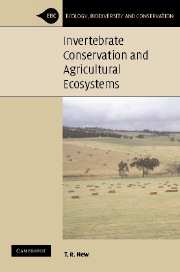Book contents
- Frontmatter
- Contents
- Preface
- Acknowledgements
- 1 Introduction: agricultural ecosystems and conservation
- 2 Agriculture and biodiversity: the place of invertebrates
- 3 Agriculture: effects on invertebrate diversity and conservation
- 4 Agricultural disturbance: diversity and effects on invertebrates
- 5 Biological control and invertebrate conservation
- 6 Cultural aspects of pest management
- 7 Extending beyond cropping areas
- 8 Field margins and landscape ecology
- 9 Pasture management and conservation
- 10 Towards more holistic management for invertebrates
- References
- Index
9 - Pasture management and conservation
Published online by Cambridge University Press: 29 July 2009
- Frontmatter
- Contents
- Preface
- Acknowledgements
- 1 Introduction: agricultural ecosystems and conservation
- 2 Agriculture and biodiversity: the place of invertebrates
- 3 Agriculture: effects on invertebrate diversity and conservation
- 4 Agricultural disturbance: diversity and effects on invertebrates
- 5 Biological control and invertebrate conservation
- 6 Cultural aspects of pest management
- 7 Extending beyond cropping areas
- 8 Field margins and landscape ecology
- 9 Pasture management and conservation
- 10 Towards more holistic management for invertebrates
- References
- Index
Summary
Management of grazing areas, in addition to the cropping areas emphasised until now, is important in invertebrate conservation. Differing grazing regimes reflect different intensity of impacts and management of more or less altered communities. Grazing affects floristic composition, and features such as sward height may also be critical for particular invertebrates, so that management of pastures and rangelands can influence a wide variety of taxa and assemblages.
Introduction
Several of the previous chapters have emphasised the influences of pest-management practices and the impetus for their refinement for greater efficiency and reducing environmental side effects. Most examples refer to cropping systems, but the principles apply also to pasture pests (which may, for example, take more than 20% of gross economic value (Landy, (1993) for Australian sheep pasture)). However, other agricultural practices associated with pastures, such as grazing, mowing (haymaking) and pasture improvement, also have important implications for conservation, with these practices being used widely for more general management of grasslands in many parts of the world. The effects of such practices, for example in the Western Australian wheatbelt (see Hobbs & Saunders, 1993) are often sufficiently severe to cause dramatic loss of vertebrate and native plant species, as taxa appraised much more frequently than invertebrates, from vast areas. In general, major features affecting invertebrates in managed grasslands include floristic composition and diversity and sward structure.
Pasture landscapes, of course, encompass far more than just grassy fields, with many low-intensity pastoral systems based on rangelands or open woodland or forest ecosystems.
- Type
- Chapter
- Information
- Invertebrate Conservation and Agricultural Ecosystems , pp. 266 - 276Publisher: Cambridge University PressPrint publication year: 2005

